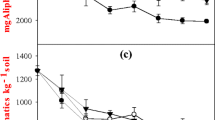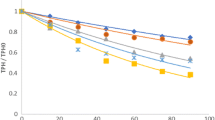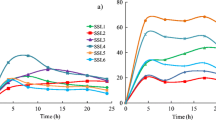Abstract
Mineralization rates of non-volatile petroleum hydrocarbons (HCs) in five different oil-contaminated soils with initial HC contents ranging from 0.1 to 13 g kg-1 are estimated as a function of environmental factors. The aim of the study is threefold, (i) to study the relevance of environmental factors that may influence the mineralization rate, (ii) to compare mineralization rates estimated in two experiments at different scales, after standardizing them to environmental reference conditions, (iii) to evaluate the CO2 production rate as a measure for the mineralization rate of HCs. Experiments were performed at laboratory scale (30–50 cm3 soil volume) in closed-jars under constant environmental conditions and in lysimeters (0.81 m3 soil volume) under dynamic climatic and hydrological conditions. A biodegradation model, coupled to transport models for soil heat, water, and gas dynamics is employed for data interpretation. The transport models are used to simulate the environmental conditions that influence the mineralization rate in the non-steady lysimeter experiments. The results show that temperature, O2 concentration and HC content have an effect on the mineralization rates. Water content could not be identified as a direct governing environmental factor. However, an indirect effect of water content is that it influences the effective gas diffusion coefficient in soils. The CO2 production rate seems to be a good quantity to express the mineralization rate of HCs for HC contents>1 g kg-1. Measured CO2 production rates standardized to reference conditions are similar for the two different experimental scales. This demonstrates that the usage of biodegradation rates obtained in the laboratory to predict the biodegradation rates under field conditions is sound, as long as the differences in environmental conditions have been taken into account.
Similar content being viewed by others
References
Blackburn, JW, Harner, EJ, Robbins, WK, Prince, RC, Clark, JR, Atlas, RM & Wilkinson, JB (1993) Experimental linkage issues of petroleum site bioremediation. Biodegradation 4: 207–230
Boesten, JJTI & Van derLinden, AMA (1991) Modeling the infuence of sorption and transformation on pesticide leaching and persistence. J. Environ. Qual. 20: 425–435
Borden, RC & Bedient, PB (1986) Transport of dissolved hydrocarbons influenced by oxygen-limited biodegradation. 1. Theoretical development. Water Resour. Res. 22: 1973–1982
Bouma, N (1991) Simulation of heat dynamics in a soil profile: A deterministic temperature model. MSc Thesis. University of Amsterdam, Amsterdam
De Jonge H, Freijer JI, Verstraten JM, Westerveld J & Van der Wielen FWM (1996) The relation between bioavailability and fuel oil hydrocarbon composition in contaminated soils. Accepted by Environ. Sci. Tech.
Dibble, JT & Bartha, R (1979) Effect of environmental parameters on the biodegradation of oil sludge. Appl. Environ. Microbiol. 37: 729–739
El-Din Sharabi, N & Bartha, R (1993) Testing of some assumptions about biodegradability in soil as measured by carbon dioxide evolution. Appl. Environ. Microbiol. 59: 1201–1205
Freijer, JI (1996) Mineralization of hydrocarbons in soils under decreasing oxygen availability. J. Environ. Qual. 25: 296–304
Freijer, JI & Bouten, W (1991) A comparison of field methods for measuring soil carbon dioxide evolution: Experiments and simulation. Plant and Soil 135: 133–142
(1993) Model application for evaluating effects of treatment scenarios on microbial decomposition of hydrocarbons in landfarms. In: Eijsackers, HPJ & Hamers, T (Eds) Integrated Soil and Sediment Research: A Basis for Proper Protection (pp 669–672). Kluwer Acad. Publ., Dordrecht
Freijer, JI & Leffelaar, PA (1996) Adapted Fick's law applied to soil respiration. Water Resour. Res. 32: 791–800
Genouw, GF, DeNaeyer, P, VanMeenen, P, Van deWerf, H, DeNijs, W & Verstraete, W (1994) Degradation of oil sludge by landfarming—a case-study at the Ghent harbour. Biodegradation 5: 37–46
Harmsen, J (1991) Possibilities and limitations of landfarming for cleaning contaminated soils. In: Hinchee, RE & Olfenbutter, RF (Eds) On-Site Bioreclamation (pp 255–272). Butterworth-Heinemann, Stoneham
Heimovaara, TJ & Bouten, W (1990) A computer-controlled 36-channel time domain reflectometry system for monitoring soil water contents. Water Resour. Res. 26: 2311–2316
Hickey, WJ (1995) In situ respirometry: Field methods and implications for hydrocarbon biodegradation in subsurface soils. J. Environ. Qual. 24: 583–588
Klute, A (1986) Water retention: laboratory methods. In: Klute, A (Ed) Methods of Soil Analysis. Part 1, 2nd edition. Agron. Monogr. 9 (pp 635–662). ASA and SSSA, Madison, WI
Leahy, GL & Colwell, RR (1990) Microbial degradation of hydrocarbons in the environment. Microbiol. Rev. 54: 305–315
Li, KI, Annamalia, SN & Hopper, JR (1993) Rate controlling model for bioremediation of oil contaminated soil. Environ. Progress 12: 257–261
Jury, WA & Ghodrati, M (1989) Overview of organic chemical environmental fate and transport modeling approaches. In: Sawhney, BL & Brown, K (Eds) Reactions and Movement of Organic Chemicals in Soils. SSSA Spec. Publ. 22 (pp 271–304). ASA and SSSA, Madison, WI
Magnusson, T (1989) A method for equilibration chamber sampling and gas chromatographic analysis of the soil atmosphere. Plant and Soil 120: 29–47
Mott, SC, Groenevelt, PH & Voroney, RP (1990) Biodegradation of a gas oil applied to aggregates of different sizes. J. Environ. Qual. 19: 257–260
Nelder, JA & Mead, R (1965) A simplex method for function minimization. Computer J. 7: 308–313
Richter, J (1987) The soil as a reactor. Modelling processes in the soil. Catena Verlag, Chemlingen, Germany
Song, H-G & Bartha, R (1990) Effects of jet fuel spills on the microbial community of soil. Appl. Environ. Microbiol. 56: 646–651
Stroo, HF, Bristow, KL, Elliott, LH, Papendick, RI & Campbell, GS (1989) Predicting rates of wheat residue decomposition. Soil Sci. Soc. Am. J. 53: 91–99
Topp, GC, Davis, JL & Annan, AP (1980) Electromagnetic determination of soil water content: Measurements in coaxial transmission lines. Water Resour. Res. 16: 574–582
Tiktak, A & Bouten, W (1992) Modelling soil water dynamics in a forested ecosystem III: Model description and evaluation of discretization. Hydrological Processes 6: 455–465
Wang, X & Bartha, R (1990) Effects of bioremediation on residues, activity and toxicity in soil contaminated by fuel spills. Soil Biol. Biochem. 22: 501–505
Whitemore, AP (1991) A method for assessing the goodness of computer simulation of soil processes. J. Soil Sci. 42: 289–299
Author information
Authors and Affiliations
Rights and permissions
About this article
Cite this article
Freijer, J.I., de Jonge, H., Bouten, W. et al. Assessing mineralization rates of petroleum hydrocarbons in soils in relation to environmental factors and experimental scale. Biodegradation 7, 487–500 (1996). https://doi.org/10.1007/BF00115295
Accepted:
Issue Date:
DOI: https://doi.org/10.1007/BF00115295




